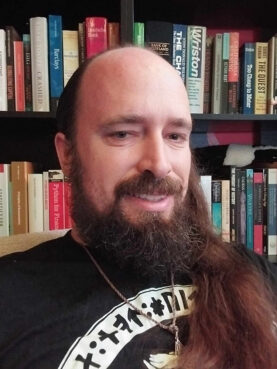(RNS) — At a press conference Friday (Sept. 12) announcing that law enforcement had a suspect in custody for the shooting death of Charlie Kirk, FBI Director Kash Patel closed his statement by saying, “Lastly, to my friend Charlie Kirk, rest now, brother. We have the watch, and I’ll see you in Valhalla.”
At a time when shocking sound bites arrive at a furious pace, Patel’s mention of Valhalla left many people scratching their heads. But members of one small pagan sect, modern Heathens, were more annoyed than puzzled.
“Heathens noticed immediately,” said Jennifer Snook, professor of sociology at Grinnell College and author of the book “American Heathens.” Valhalla, she explained, is “part of their sacred lore.”
There are no firm statistics on how many people practice Heathenry, a contemporary religious movement adjacent to modern paganism. As Snook explained, Heathens focus on the “cultural folkways, histories and mythology of Nordic and Germanic countries,” in which Valhalla is populated by warriors who died valiantly in battle.
Many Heathens “took issue,” Snook said, with the “idea of Valhalla being used so casually by a guy who Heathens perceive as unworthy of the honor. Patel, who was raised in a Hindu family, has not served in the military and Kirk did not die in battle, even if the right perceives his death to have been committed as part of an ideological one.”
Benjamin Kowalksy-Grahek, president of the U.S.-based Heathen organization The Troth, called Patel’s statement terrifying because it suggested that a cultural war had already turned hot. “If Patel believes Charlie is going to Valhalla, then he believes Charlie died in battle,” rather than being a victim of yet another senseless gun crime, Kowalksy-Grahek said.
“The framing of this as part of a war and Charlie Kirk as a warrior is the most disturbing part of all of this,” he said.


Ryan Smith, a historian and a practicing Heathen who hosts the “Wayward Wanderer” podcast, described his own reaction to Patel’s comment as “bemusement, wearied resignation and a bit of disgust.”
Smith called the comment yet another “perfect example” of how Norse imagery has been purposely co-opted and “distilled down to a hypermasculine pastiche devoid” of its true cultural and religious meaning.
The Rev. Irene Glasse, a practicing inclusive Heathen and former U.S. Marine, agreed, labeling Patel’s use of Valhalla “stereotypical co-opting of Norse mythology to serve toxic masculinity.”
Glasse pointed out that Valhalla, which is ruled by the prominent Norse god Odin, is not the only possible destination for those who die in battle. Folkvangr, ruled by the goddess Freyja, is another. But, suggested Glasse, you never hear “See you in Folkvangr.”
“Descriptions of Valhalla,” Glasse explained, “include a lot of the Viking tropes that appeal to the toxic masculinity part of white supremacism — fighting all day, feasting all night, Valkyries carrying mead … the works,” she said. “This version of Valhalla is like an eternal biker bar.”
A larger problem, according to Heathens and experts who study the practice, is that Valhalla has become one of several Norse symbols that are regularly used as “racist, white nationalist dog whistles.”
Smith, who has been studying white supremacist groups for more than a decade, explained, “Right wing and far-right movements have a very consistently exploitative relationship with history, where chunks are taken out of context to justify their policies and goals.”
In 2021, the stage at a Conservative Political Action Conference’s gathering in Orlando, Florida, was built in the shape of a rune in the ancient Nordic alphabet, known as the Odal Rune, or the Othala or Othilan Rune, that symbolizes “heritage, possessions, property and inheritance,” according to Smith’s 2019 book, “The Way of Fire and Ice.“
However, Snook pointed out, CPAC’s rune was not the standard Norse version, but had “little legs,” similar to the version used by neo-Nazis.
How does this unrelenting use of Norse imagery and mythology affect practicing Heathens?

Most Heathens, said Glasse, “end up developing a sort of callus to having our beliefs appropriated,” but she urged Heathens to take precautions to distinguish themselves from far-right extremist groups. “Incidents like this one,” she said, “mean that we have to keep aggressively demonstrating that we are inclusive in terms of how we present ourselves and what we say.”
Glasse is one Heathen who uses the term “Inclusive” as a distinguishing marker.
Kowalksy-Grahek, who prefers the term “Universalist,” said, “We’ve worked very hard to overcome” an increasing fascination with far-right warrior ethos. “We aren’t reacting to (the news) as much as we are just doing the work that we know needs to be done to keep (the) vision alive,” he said.
That vision, however, is rarely witnessed outside the pagan and Heathen world, and Glasse believes that is one of the biggest challenges. “Our culture only tends to come up when someone from the alt-right is scrabbling for a mythology that supports their hate,” she said.
Or when it becomes a feature of mainstream entertainment. The success of the Netflix series “Vikings,” which brought Nordic history, culture and mythology to the mainstream, garnered a spinoff called “Vikings: Valhalla.”
A 2015 comedy titled “See You in Valhalla” and a 2019 fantasy film called “Valhalla: The Legend of Thor” also made use of the term, as does the video game Assassin’s Creed Valhalla.
The Til Valhalla Project is a veterans organization that works to help retired soldiers and honors those who have died on the battlefield.
Mainstream uses of Norse symbols, even those not echoing any right-wing ideology, Smith believes, often fall flat. “Nordic spirituality is far deeper and richer than the shallow, stale stereotypes that permeate many corners of pop culture and society today, as are many pagan spiritual practices,” he said.
He hopes that such mentions will bring people to the original source material on which Heathens base their religious practice. “I think anyone who is interested in Heathen spirituality,” he said, “should explore the far more plentiful examples of hospitality, praise for generosity, scorn for oppressors, the beauty of their art and poetry, and the lust for life.”
Original Source: